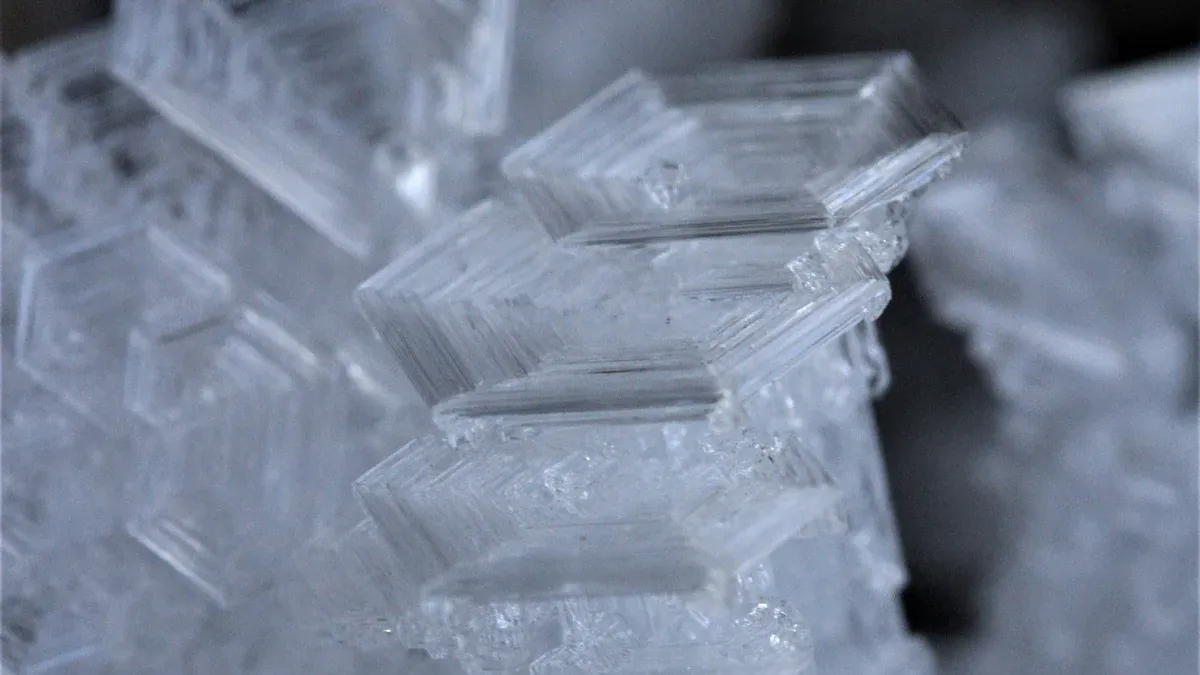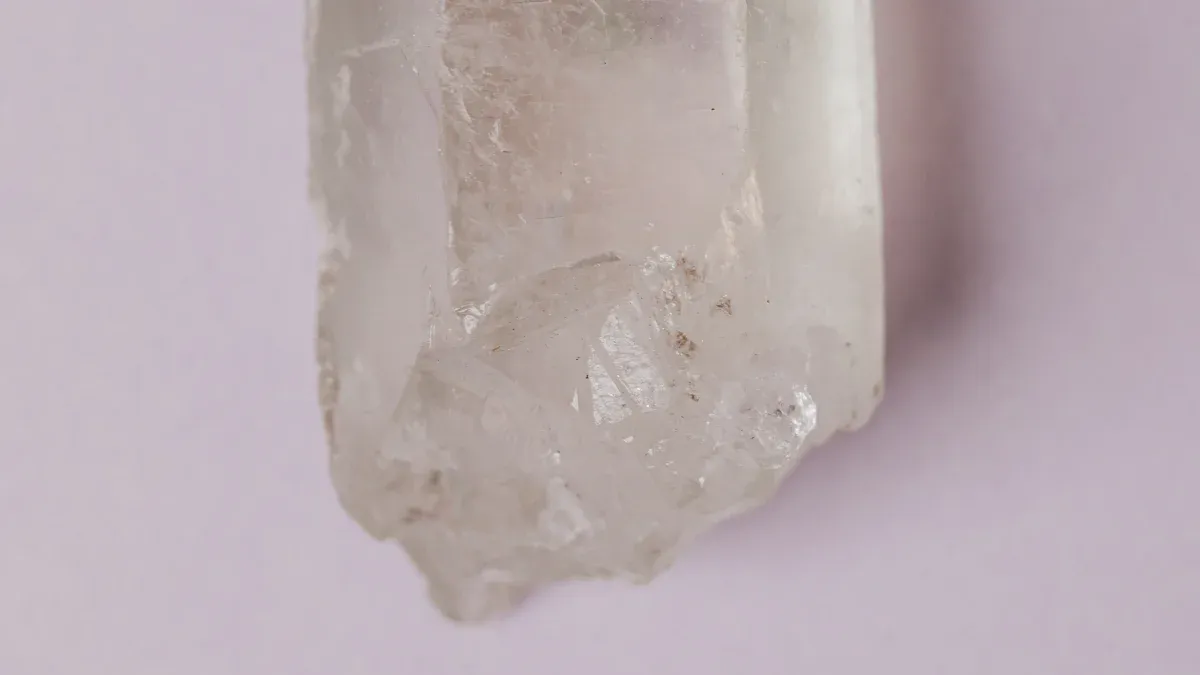asd njas bfiujhg bauiojagbua ogbao sabnlgnalkdgnlakgdnasassadasaf asdsaf asfasf as afa
2025 Insights on Transparency in Mineralogy

Transparency in minerals, or diaphaneity, refers to how light interacts with a mineral's surface. I find it fascinating that we categorize minerals as transparent, translucent, or opaque based on this interaction. Understanding these categories is crucial. Transparency plays a vital role in identifying minerals, especially when other properties are unclear. For instance, the surprising transparency of sphalerite can catch even seasoned collectors off guard. This highlights the importance of transparency minerals in confirming identities and ensuring quality in gemstones.
Key Takeaways
- Minerals show three types of transparency: transparent, translucent, and opaque, each affecting how light passes through and their uses in jewelry and identification.
- Impurities, structural defects, and environmental conditions like temperature and radiation change a mineral's transparency by altering its internal structure.
- Techniques like X-ray Diffraction and Energy Dispersive Spectroscopy help identify minerals accurately by analyzing their composition and transparency.
- Transparency greatly influences gemstone quality, enhancing beauty and market value by allowing light to interact with the stone.
- New technologies and sustainable mining practices are improving how we study and preserve mineral transparency for a responsible and innovative future.
Types of Transparency Minerals

Transparent Minerals
Transparent minerals allow light to pass through them without significant scattering. This quality makes them ideal for various applications, especially in the gemstone industry. I find it fascinating how minerals like quartz and fluorite exhibit this characteristic. When I hold a piece of clear quartz up to the light, I can see right through it. This clarity enhances its beauty and value, making it a favorite among collectors.
Recent research summarized in The Canadian Encyclopedia highlights that transparency among mineral species varies significantly. Some minerals can be nearly transparent, while others may appear almost opaque. This variability stems from a mineral's ability to transmit or absorb light. For example, fluorite can display a range of transparency, depending on its impurities and structural defects.
Translucent Minerals
Translucent minerals allow some light to pass through but scatter it in the process. This quality gives them a unique appearance, often resulting in a soft glow. I remember the first time I encountered a piece of jade. Its translucent quality captivated me, as light danced through the stone, creating an ethereal effect.
Minerals like opal and chalcedony fall into this category. They can exhibit beautiful colors and patterns, making them highly sought after in jewelry. The interplay of light within these minerals adds depth and intrigue. I often encourage budding gem enthusiasts to explore translucent minerals, as they offer a different kind of beauty compared to their transparent counterparts.
Opaque Minerals
Opaque minerals do not allow light to pass through them at all. This characteristic can make them less desirable for certain applications, but they still hold significant value in the mineral world. I find it interesting how minerals like hematite and pyrite can be strikingly beautiful despite their opacity.
An empirical study measured the light absorption coefficients of 32 quartz samples to evaluate their opacity. The researchers found a quantitative relationship between the opacity of quartz lumps and bubble formation in fused silica glass. This study provides direct empirical support for classifying minerals as opaque based on light transmission rates. Specifically, quartz lumps with opacity values below 2/kg exhibited bubble sizes comparable to those produced by commercial powders. This research underscores the complexity of mineral classification and the importance of understanding transparency minerals.
Factors Affecting Transparency in Minerals

Impurities
Impurities can significantly alter the transparency of minerals. When I examine a mineral, I often consider the presence of foreign elements. These impurities disrupt the intermolecular bonds within the mineral's structure. For example, laboratory experiments show that impurities in quartz and amorphous silica destabilize their structure. This destabilization increases the mineral's susceptibility to dissolution.
I find it fascinating how ion irradiation can induce structural changes in quartz. Using techniques like transmission electron microscopy (TEM), researchers observe a transition from crystalline to amorphous states. Fourier-transform infrared spectroscopy (FTIR) reveals shifts in vibrational modes, indicating bond distortions. These changes directly affect the optical properties of the minerals. Although the studies do not provide a direct quantitative correlation between impurity concentration and transparency changes, they clearly link impurity-induced structural disorder with altered optical behavior in minerals.
Structural Defects
Structural defects also play a crucial role in determining how light interacts with minerals. I often come across minerals with metamict textures, where radiation-induced structural disorder destroys the crystal lattice. This results in amorphous or disordered structures, which can significantly impact light transmission.
High-resolution transmission electron microscopy data shows that crystal defects and atomic-scale structural disorder influence the physical properties of minerals. These defects can alter chemical and physical characteristics at scales beyond what a light microscope can resolve. For instance, the density of structural defects directly affects optical properties. In fluorite, Frenkel defects create color centers by trapping electrons, which modifies light absorption and fluorescence. This illustrates how structural defects can dramatically change the way light interacts with minerals.
Environmental Conditions
Environmental conditions can also affect mineral transparency. Factors such as temperature, pressure, and exposure to radiation can lead to changes in a mineral's structure. I remember studying how extreme temperatures can cause thermal expansion, which may introduce microfractures in minerals. These fractures can scatter light, reducing transparency.
Additionally, minerals exposed to radiation may undergo changes that affect their optical properties. For example, prolonged exposure can lead to the formation of defects that alter light transmission. Understanding these environmental influences is essential for anyone interested in mineralogy. It helps me appreciate the delicate balance that determines a mineral's beauty and value.
Implications for Mineral Identification and Transparency
Identification Techniques
Identifying minerals accurately is crucial for both collectors and professionals. I often rely on various techniques to ensure I classify minerals correctly. One of the most effective methods is X-ray Diffraction (XRD). This technique provides a positive correlation between diffraction intensity and mineral content, allowing for rapid analysis of minerals like calcite and dolomite. However, I must note that XRD can struggle with overlapping peaks at low mineral content.
Another powerful tool is Energy Dispersive Spectroscopy (EDS). This method enables me to identify low-content minerals, such as pyrite, with impressive accuracy. It scans elements and provides both qualitative and quantitative data. I find it fascinating how these techniques can reveal so much about a mineral's composition.
To give you a clearer picture, here’s a summary of some identification techniques I often use:
| Technique | Quantitative Accuracy / Data | Mineral Types / Features Identified | Notes / Limitations |
|---|---|---|---|
| X-ray Diffraction (XRD) | Positive correlation between diffraction intensity and mineral content | Common rock-forming minerals including calcite, dolomite | Susceptible to interference from overlapping diffraction peaks; cannot directly observe morphology |
| Energy Dispersive Spectroscopy (EDS) | Enables both qualitative identification and quantitative calculation | Low-content minerals like pyrite | Differences exist compared to XRD but can be reduced with improved sampling and resolution |
Gemstone Quality Assessment
When it comes to gemstones, transparency plays a vital role in quality assessment. I often evaluate gemstones based on their clarity and light transmission. For instance, I remember examining a stunning piece of garnet. Its transparency allowed light to dance within, enhancing its allure. This quality directly impacts its market value.
Recent case studies highlight the effectiveness of transparency-based identification methods. For example, analytical fingerprinting techniques have successfully verified the provenance of minerals like zinc sulphide concentrates. These methods analyze measurable properties, creating a reference database that confirms the origin of raw materials. Such advancements reassure me that transparency minerals can be reliably identified, ensuring quality in the market.
Future Trends in Transparency Minerals Research
Technological Advances
I am excited about the technological advances shaping the future of transparency in minerals. Recent surveys highlight several innovations that enhance our ability to measure mineral transparency. For instance, hyperspectral mapping with high spatial resolution allows for detailed distribution mapping of minerals. This technique helps me visualize how minerals relate to mineralization. Automatic spectroscopic scanning of drill cores improves the precision and efficiency of mineral characterization.
Moreover, AI-powered data processing methods, such as neural networks and deep learning, facilitate automatic mineralogical core logging. These advancements improve accuracy and reduce labor, making my work more efficient. Advanced geophysical techniques like induced polarization (IP) and airborne electromagnetics (EM) provide deeper insights into subsurface information. While these technologies do not measure transparency minerals directly, they significantly enhance spectral and mineralogical characterization, indirectly supporting better assessments of transparency.
Sustainability Considerations
Sustainability is becoming increasingly important in mineral research. I believe that adopting sustainable mining practices can significantly impact mineral transparency. Here are some key trends I find compelling:
- Sustainable mining integrates technological advancements like dry stacking and AI-enabled waste sorting to reduce waste.
- Regulatory frameworks aligned with international sustainability goals support transparency and environmental safety in mineral supply chains.
- Multi-stakeholder cooperation among governments, industries, and communities is essential for advancing sustainable mining.
- Circular economy principles recycle mining waste, extending the mineral lifecycle beyond extraction.
- Renewable energy adoption in mining operations reduces carbon footprints and supports sustainability.
These practices not only enhance transparency but also promote responsible mining methods. I see a growing market for sustainable mining solutions, indicating an increasing focus on research and development in this area. As we move forward, I am optimistic that these trends will lead to a more transparent and sustainable future in mineralogy.
In summary, transparency in minerals plays a crucial role in identifying and assessing gemstone quality. I have learned that understanding the types of transparency—transparent, translucent, and opaque—helps me appreciate the beauty and complexity of these natural wonders. Ongoing research is vital. A meta-analysis revealed significant variability in mineral content due to factors like farming practices. This highlights the need for continued exploration of transparency minerals to clarify health-related outcomes and refine methodologies.
Education in mineralogy fosters a deeper understanding of these concepts. I encourage everyone to engage with this fascinating field. Together, we can ensure a brighter future for transparency in mineralogy.
0users like this.






